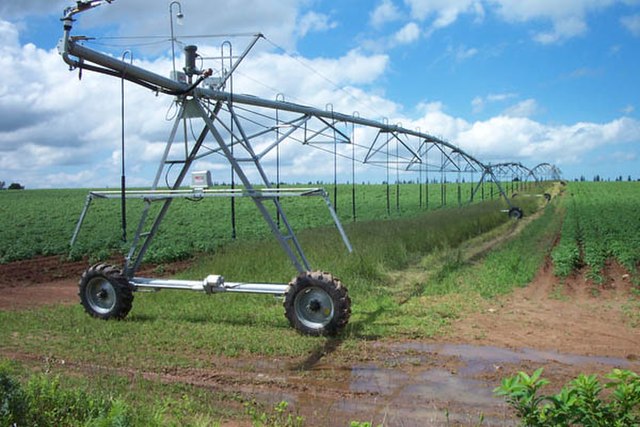Soil Moisture and Irrigation Management
Learn more about the importance of soil moisture to sweetpotato production and irrigation management strategies!
Importance of Soil Moisture
Soil moisture is an important variable to take into consideration in sweetpotato production. Without adequate soil moisture, sweetpotato plants undergo drought stress which can ultimately lead to extensive damage to the storage roots. Historically, the damage caused by drought stress has been attributed to herbicide applications in sweetpotato (Smith and Villordon, 2012). However, researchers have recently shown that damage symptoms were inducible when supplemental irrigation was turned off during critical storage root initiation stages when plants were near the point of wilting (Smith and Villordon, 2012). Damage symptoms that may be apparent from inadequate soil moisture include extensive lignificaiton of the storage roots and misshapen storage roots (Smith and Villordon, 2012).
Furthermore, overfilling of the root zone, the primary zone for water uptake, can result in chemical leaching. Chemicals that are more likely to leach from the soils when oversaturated include nitrates/nitrogen (Smith and Villordon, 2012). Leaching of these chemicals can lead to increased costs due to reapplication of chemicals and can impact water quality. Generally, it is recommended to leave room for about 0.5 to 1 inch of rainfall that may occur after irrigation to avoid overfilling the root zone (Smith and Villordon, 2012).

“Irrigation system near Emerald, PEI (30440864)” by Larry / CC BY 2.0
Irrigation Management in Sweetpotato
An irrigation management plan for sweetpotato production should be based on optimizing soil moisture. The optimal soil moisture for sweetpotato production is between 50% field capacity and field capacity, which is the water content held in the soil after excess water drains (Smith and Villordon, 2012). In particular, soil moisture should be optimized during the critical storage root initiation period and further until harvest (Smith and Villordon, 2012). The critical storage root initiation period occurs very early after transplanting sweetpotato planting material, around 13 days (Smith and Villordon, 2012). Around the time of storage root initiation, it is estimated that the bulk of the root system is within the upper 12 to 15 inch depth of soil (Smith and Villordon, 2012), thus, it is critical to ensure that soil moisture is optimized near this soil depth. Optimizing soil moisture at this depth, especially until harvest, will support the expansion of the root diameter, also known as bulking.
An irrigation management plan and associated optimization of soil moisture is highly dependent on multiple factors. The most important factor when discussing optimal soil moisture is soil type or texture. For sweetpotato production, sandy to loamy sand soil types are preferable (Stoddard, 2013). Within this range of soil types, each soil type has a unique water-holding capacity and soil infiltration rate that impact an irrigation management plan. For instance, soils that have a higher water-holding capacity require less frequent irrigation events while soils with a lower infiltration rate require lower application rates. In addition to soil type or texture, factors such as rainfall frequency, plant growth stage, air temperature, humidity, and evapotranspiration must be considered when developing an irrigation management plan to optimize soil moisture (Kemble et al., 2022).
Below are two tables that identify the water-holding capacity and soil infiltration rate for different soil types.
Table 1 and 2. The below tables has been adapted from the 2022 Southeastern US Vegetable Crop Handbook.
| Soil Texture | Available Water Holding Capacity (water/inches of soil) |
|---|---|
| Coarse sand | 0.02–0.06 |
| Fine sand | 0.04–0.09 |
| Loamy sand | 0.06–0.12 |
| Sandy loam | 0.11–0.15 |
| Fine sandy loam | 0.14–0.18 |
| Loam and silt loam | 0.17–0.23 |
| Clay loam and silty clay loam | 0.14–0.21 |
| Silty clay and clay | 0.13–0.18 |
| Soil Texture | Soil Infiltration Rate (inch/hour) |
|---|---|
| Coarse sand | 0.75–1.00 |
| Fine sand | 0.50–0.75 |
| Fine sandy loam | 0.35–0.50 |
| Silt loam | 0.25–0.40 |
| Clay loam | 0.10–0.30 |
Irrigation Methods for Sweetpotato Production
The below list has been adapted from the LSU AgCenter Improving Sweet Potato Production Efficiency: Optimizing Soil Moisture and Irrigation Management Factsheet.
Center Pivot Irrigation
- Most efficient method of providing supplemental water for sweetpotato production.
- Timing and placement are more accurately controlled.
- Can be used during all production stages.
- Can be used during harvest to improve harvesting conditions.
Furrow Irrigation
- Can be an efficient method for irrigation of an established sweetpotato crop, but only if properly managed.
- Longer application time of furrow irrigation is required if establishing a sweetpotato crop.
- Rainfall events can compound with furrow irrigation to further saturate (oversature) the soil during storage root initiation.
Travelling Irrigation Gun
- Can be used during all production stages.
- Most commonly used with established sweetpotato crops for supplemental water delivery.
- Can be used prior to planting or during harvest to improve harvesting conditions.